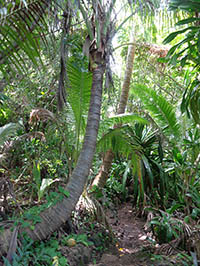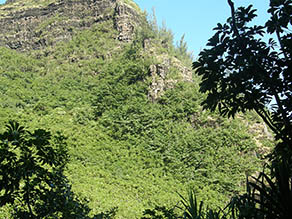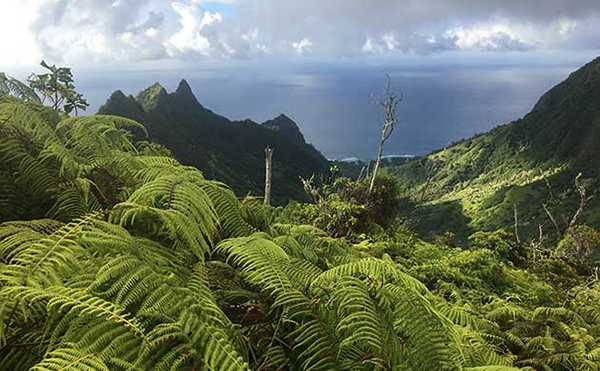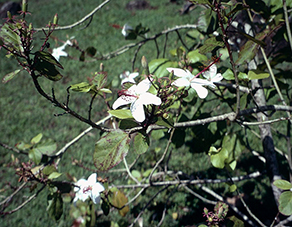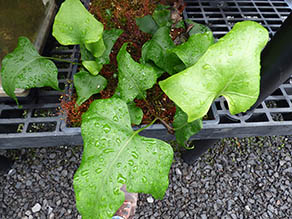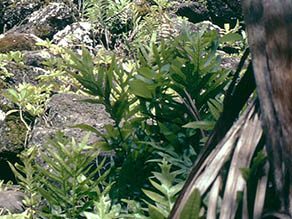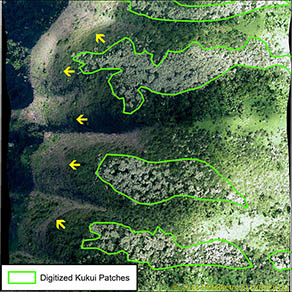 |
 |
 |
 |
||||||
|
|
|
|
|
|
|
|
|
|
|
| Areas | Seasons | Forest | Ocean | Sky | Language | Sources & Links | |||||||||
 |
|
 |
|||||||
 |

Three forest ecosystems characterize the vegetation in Limahuli valley. Chipper explains: Lowland Rainforest: "This first ecosystem is characterized by 'ōhi'a lehua as one of the dominant trees. We find 'ōhi'a lehua growing naturally here nearly down to the ocean. There are remnant populations in the valley of naturally occurring 'ōhi'a lehua all throughout the Limahuli Garden area. Due to the rainfall regime, we have a lowland rainforest that comes nearly down to the ocean." The Slopes: "Once you get up a little bit more onto the ridges, it gets drier. There are two effects for that. "First, because it's steeper, the rain tends to run off a little more quickly. As you get up on the slopes, you may get an equal amount of rain as on a flat part, but the rain is going to run off. So less water is actually available. "Second, you're exposed to the drying effect of the trade winds. So the plants that would grow there tend to be more like plants that would grow in a dry area. "So we call this area the mesophytic or mixed-mesophytic ecosystem, which is more of a transitional ecosystem between rainforest ecosystem and dry forest. And the dominant species in that kind of ecosystem is lama, the native ebony, sacred to the goddess Laka, who was goddess of the hula and goddess of the forest."
Mountain Rainforest: "Then, in the very back of the valley, up above the waterfall, we begin the transition into the Mountain Rainforest, in which the primary dominant species is chyrodendron—'ōlapalapa is the Hawaiian name for it—and 'ōma'o ferns, and things like that.
"There is a lot of overlap in these different zones, but there weren't a lot of resources in that upper area, because its so difficult to get to--it's not like you could go up there and get a canoe log and bring it down, or something like that--so my guess is that probably it was primarily an area for the bird catchers. It would have been a natural habitat for all of the forest birds up there." “It’s a unique habitat up there," Merlin adds. “Limahuli is kind of at the northwestern point of the island where it starts to turn into Nā Pali coast, but then the other direction is all the north shore. So botanically speaking, we’re kind of at a meeting of two different ecoregions so that in terms of endemic species, I think we’re the second most diverse valley in the state as far as indigenous and endemic plants. There’s a lot of really rare plants up there that are now protected by that fence. It’s awesome." Plants unique to Kaua‘i—endemic plants—are found within these zones, including a few that are endemic to that area (found nowhere else). Hā‘ena is renowned for a native plant common throughout the islands, the scented laua‘e fern. Today most people are familiar with an introdued species also called laua‘e, due to its similar fragrance to the now-rare native species, but it is an Australian introduction that has become naturalized in the islands' forests.
|
 |
|
 |
But the forests were also modified and used by Hawaiians. Kawika explains: “Coming into the forest and looking at that, I think the real subtle nuances in management come at not a species level but on a kind of a landscape level. If you look at the higher islands, how are these ahupua‘a—or watersheds, or whatever you want to call them—being managed in the context of high islands? How did the Polynesians bring in their plants like ‘ulu and kukui and ‘ōhi‘a‘ai and la‘ī and integrate them into the forest? And then manage the forest so it maximized biodiversity? “Agroforestry is to me a really interesting thing for several reasons. One, in the context of our knowledge of ahupua‘a, it’s the one huge puka [hole, gap] that we have almost no documentation of. But what we do have is all of these footprints in the forest. "We have all of these old groves of kukui trees and mountain apples, and in some places, ‘ulu. And we see the banana and the tī leaf. So we’ve been having a lot of conversations about how this agroforestry system used to work. “And the reason why that’s relevant in the context of modern sustainability, for example, is the debate about biofuels. People are talking as if it’s food versus fuel. Are we going to do food plants, or bio-fuels? Either way you’re jamming us up because we are not meeting our needs. “But if you look at agroforestry in the context of other kinds of agriculture, look at the way the Hawaiians did it, the alluvial plains were all kalo, but up in the forest, that was a managed system. You have your kukui going up the slopes and that was your bio-fuel. But you don’t bring your kukui down to the lo‘i and plant a closed canopy of kukuis, you’re just making a lot of kukui oil, and that’s ridiculous. So it’s really trying to figure out the system and how agroforestry related to agriculture in the fields and how those two are managed in concert to provide for all of the needs of the people, not only food and medicine, construction material, but bio-fuel as well. “I think there is of lessons there about sustainability that if we can try to wrap our minds around this and look at the evidence that’s left and how it’s laid out in relationship to the remaining archeological sites and the typography of the valley and all of that, we might be able to figure out some pretty interesting things that we can start filling that void of knowledge about how agroforestry worked in the ahupua‘a.”
|
 |
|||
 |
Plants unique to Kaua‘i—endemic plants—are found within these zones, including a few that are endemic to that area (found nowhere else). At Limahuli Gardens, these plants are being carefully reproduced and preserved. The plants of the forest, in Hawaiian culture, are directly linked to the living beings of the Ocean.
|
 |
||
 |
|
 |
||

|
|
||||
| Copyright 2018 Pacific Worlds & Associates • Usage Policy • Webmaster |
||||
